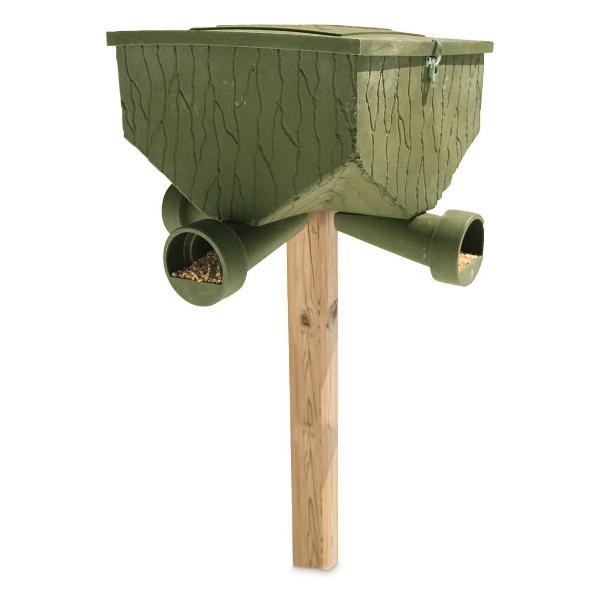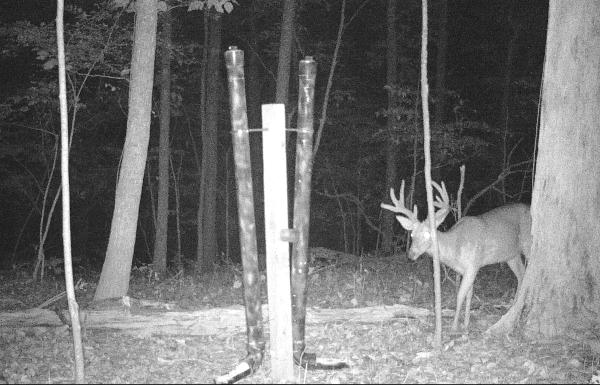When shopping for a new deer feeder, it won’t take long to figure out that there are plenty of quality feeder options on the market today. In terms of buying or purchasing a feeder, your options are typically limited to one of two commercially available feeder styles:
- Spin cast or Broadcast Feeders
- Gravity Feeders
Let’s take a more in-depth look at each type and then go over each style’s pros and cons.
Broadcast Feeders
Over the years, I’ve heard broadcast feeders called all sorts of names, including:
- Spin cast feeders
- Spinner feeders
- Automatic Feeders
- Electric Feeders
- Throwing Feeders

These are all basically different names or descriptions for a broadcast feeder. This style of feeder uses a spinning mechanism to dispense feed. The spinning mechanism (which also goes by several different names as well) dispenses feed as it spins. The spinning motion force may adjust to control the amount of feed distributed and how far the feed is thrown.
The broadcast portion of the description comes from the feed being broadcasted out from the feeder. If you aren’t sure what I’m describing, think of a broadcast fertilizer that uses a spinning platform to uniformly throw fertilizer pellets out as the fertilizer cart is pushed forward.
A broadcast feeder works much the same way in terms of how the feed is distributed. Most broadcast feeder models are built on a tripod or up on legs, although some broadcast feeder models are made to hang off a tree or limb.
But, like most things in life, broadcast feeder systems have pros and cons. Let’s discuss those in greater detail:
Spincast Feeder Pros
- Most are powered by a battery and can be set to dispense feed on a schedule.
- Depending on the feed storage area’s size attached to the feeder, coupled with how often feed is dispensed, this deer feeder style can go for an extended period of time without having to be refilled.
- Although most broadcast-style feeders are made specifically for feeding deer, this style is versatile enough to be used to feed other game species.
- This feeder style is usually mounted several feet off the ground on a 3 or 4 legged platform, making the feeder reasonably stable.
- The spinner style of feeder can be used with almost any type of dry, seed, or pellet based feed like corn, protein pellets, or dry molasses.
- These types of feeders usually feature a covered and secured feed storage area, which helps keep the feed fresh and dry.
Spincast Feeder Negatives
- This style of feeder is bulky to move and can be difficult for a single person to set-up. They generally take at least two individuals to set-up, with some larger models even requiring more than two people.
- Most broadcast feeders are powered by an electrical motor that runs on a battery. Eventually, the battery will need to be replaced or recharged.
- If any of the electrical components or motor fails, the feeder stops dispensing food.
- Without safeguards or deterrents in place, broadcast feeders are susceptible to feed raiders like raccoons and squirrels.
- Broadcast feeder models with a timer may have a learning curve in terms of learning how the feeder works and how to set the feed timer.
Gravity Deer Feeders
This style of feeder is named as they rely on gravity to dispense the feed. Gravity based deer feeders can range from the very simplistic style all the way up to more complicated models with multiple feed tubes and special valves that release more feed based on a pulley system.

Gravity feeders come in many variations and also have other names or descriptions, including:
- Drop feeders
- Tube Feeders
- Self-feeders
This feeder style features far fewer moving parts than a broadcast feeder and may rely on deer eating the feed from a tube for more feed to be dispensed.
Gravity feeders come in many styles, including the following:
- Tube feeders
- Hanging feeders
- Box style feeders
As far as homemade feeders or DIY deer feeders go, the gravity style feeder is the most common type people build.
Let’s take a second and discuss the pros and cons associated with gravity deer feeders:
Gravity Deer Feeder Pros
- This style or type of feeder is easier to set-up and configure than a broadcast-style deer feeder. Most (but not all) gravity-style feeders can be set-up by a single person.
- Depending on the specific feeder type and configuration, a gravity feeder can be less bulky and easier to transport.
- Gravity feeders have fewer moving parts than a broadcast or spin-cast feeder, making this style less likely to malfunction or break down.
- As this type of deer feeder relies on gravity as a means of dispensing feed, there are no batteries to manege or components to wear out.
Gravity Deer Feeder Cons or Negatives
Depending on the feeder configuration, gravity feeders tend to have a smaller feeder storage area compared to broadcast feeders. This design means they hold less feed, so they usually have to be refilled more often than a spin cast feeder.
While gravity feeders have fewer moving parts, the feeder tube can become clogged with feed and not dispense properly.
Most gravity feeder models offer little protection or deterrence from squirrels and raccoons, who will consume as much of the feed as possible. I wrote another post here discussing ways to squirrel-proof a deer feeder.
Most gravity-based feeders have no timer or scheduling apparatus, so the feed is dispensed at a less controllable rate compared to a broadcast feeder.
Which Feeder Style is Best?
The answer to that question really depends on several factors, including:
- Your budget
- How the feeder is being used, and it’s primary purpose
- How involved do you want to be in terms of feeder refill and maintenance?

Let’s discuss each factor individually, so I provide some additional details:
Budget
When shopping for a deer feeder, budget always plays a role, and here’s why: Feeders with more features and larger storage areas usually cost more than a feeder with fewer features. Features and style usually determine the feeder model shoppers gravitate towards.
For example, if you want more of a set and forget style of feeder, you’re going to focus on a tripod style broadcast feeder with a large hopper for as much feed storage as possible. A set-up like that will cost anywhere from $150 on the lower end, all the way up to $1000 or more for a top-end, steel deer feeder built like a tank.
In comparison, a commercially made gravity feeder for a small plot of land can cost between $30 and $100.
As you can see from those numbers, there’s a wide range of pricing associated with deer feeders.
How is the Feeder Being Used?
Typically, deer feeders are put into place for one of two uses:
- Hunting purposes
- Wildlife purpose
The majority of commercially made deer feeders are used by hunters who practice deer management and want to keep the deer population high for hunting purposes. Although many anti-hunters would argue, this type of conservation as supplemental feeding programs helps keep deer healthy and alive during the winter months.
Wildlife and nature fans are the second most common purchasers of deer feeders, but they are typically buying for use in their backyard. They are feeding deer (where legal, and I can’t stress that enough) to help the local herd stay healthy and enjoy viewing them as they feed.
While both groups are doing the same activity, it is done for very different purposes and, therefore, have different feeder style requirements.
Most wildlife lovers will look more towards the less expensive and more simplistic deer feeder options as they don’t face the same challenges that hunters face.
Deer hunters generally prefer to refill the feeder, check batteries, do feeder maintenance, etc., as little as possible to disturb the deer as little as possible. This approach is very different from the wildlife lovers who are not concerned about spooking the deer and don’t mind refilling the feeder more frequently.
My point in discussing how the feeder is being used is this: deer hunters are generally going to be interested in a more hands-off approach for a feeder, which means they are usually going to willing to spend more money on a feeder compared to a wildlife fan or someone feeding deer in their backyard.
Level of Feeder Maintenance
When I’m talking to customers at my day job about deer feeders, I usually ask how involved they want to be doing feeder maintenance such as feeder refills, checking batteries, etc.
How they answer will play a direct role in the type of feeder that I recommend or suggest. For people who don’t mind refilling a feeder every few days or just want to feeder the deer in their backyard, I usually recommend a gravity-style feeder as they end to be the easiest to set-up and maintain.
For hunters who want to refill the feeder as little as possible, I generally suggest a broadcast style feeder with a timer and feed control. However, there are plenty of hunters out there who prefer a gravity style feeder set-up and don’t mind doing more frequent feeder management as it also gives them the changes to check their trail cameras more often.
I use broadcast feeders (I use the Big Boss and Texas Hunter brands personally) with a 50 gallon to 75-gallon hopper (meaning the feeder’s storage area will hold 50 to 75 gallons of feed). I prefer this approach as I like to refill the feeders as infrequently as possible, both from a convenience perspective, and to disturb the deer as little as possible.
At the end of the day, the feeder you choose is really a personal decision based on your individual needs and personal budget.




